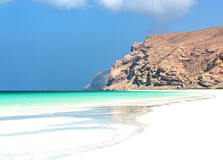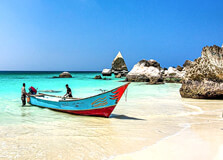
- Home
- Travel Packages
- Top Destination
-
Travel Attraction
By Category
Top Attraction

- Travel Agents
- Car Rentals
- Hotels

Shua'ab Beach, located on the stunning Socotra Island in Yemen, is one of the most breathtaking and untouched beaches in the world. Known for its pristine white sands, crystal-clear turquoise waters, and dramatic natural beauty, Shua'ab Beach is a hidden gem on Socotra that attracts travelers seeking solitude, relaxation, and adventure. The beach, located on the island's southern coastline, offers an unparalleled experience for nature lovers, photographers, and those looking to explore the unique ecosystems of this UNESCO World Heritage site. How to Reach Shua'ab Beach, Socotra Island, Yemen Getting to Shua'ab Beach requires some effort, as Socotra Island is relatively isolated. The most common way to reach Socotra is by flying into Socotra International Airport (SQO), located in the capital city, Hadibu. Flights to Socotra are available from Yemen's major cities, such as Sana'a and Aden. The flights are not always regular, so it’s crucial to plan ahead, book in advance, and be flexible with your travel dates. Once you arrive on Socotra Island, getting to Shua'ab Beach typically requires hiring a local guide or driver, as the beach is located in a more remote area of the island. The journey to the beach can be a bit challenging, as the island’s roads are rugged, and it may take a few hours to reach the coast from Hadibu. However, the trip is worth it, as the beach is one of the most picturesque spots on the island. Weather in Socotra Island, Yemen Socotra Island enjoys a tropical climate with hot and dry weather for most of the year. The island experiences mild temperatures from October to March, which is considered the best time to visit. During this period, the weather is more comfortable for outdoor activities like hiking, swimming, and exploring the island’s unique natural attractions. From June to September, the temperatures can soar to over 40°C (104°F), making it less ideal for daytime activities. If you plan to visit during the warmer months, make sure to stay hydrated and plan your excursions for early morning or late afternoon to avoid the midday heat. Rain is relatively rare on Socotra, with most of the island receiving only a few millimeters of rain annually. However, occasional monsoon rains occur between June and September, which can add a refreshing touch to the island’s dry landscape. Timing of Visit to Shua'ab Beach The best time to visit Shua'ab Beach and Socotra Island is from October to March. During this time, the weather is mild and more suitable for outdoor exploration. The dry, pleasant conditions make it ideal for beach activities like swimming, snorkeling, and enjoying the natural beauty of the beach without the scorching heat of summer. During the summer months, the weather can be extremely hot, making it less comfortable for visitors. However, if you can bear the heat and plan your activities around the cooler hours of the day, a visit during the summer months can still be rewarding. Why Famous for Shua'ab Beach, Socotra Island, Yemen? Shua'ab Beach is famous for its pristine beauty and its position within the exceptional ecosystem of Socotra Island. The beach is surrounded by rugged cliffs, and its waters are so clear that you can see the coral reefs beneath the surface. The beach is relatively undeveloped, which adds to its charm and makes it a true paradise for those looking for tranquility away from the crowds. The beach is also known for its rich biodiversity. The waters off Shua'ab Beach are home to diverse marine life, including vibrant coral reefs, exotic fish, and even sea turtles. The beach is a popular spot for snorkeling and diving, as the underwater ecosystem is as spectacular as the land-based scenery. Its secluded nature makes it an ideal destination for nature lovers, photographers, and those who want to enjoy the beauty of the natural world without the interference of mass tourism. Entry and Visit Details About Shua'ab Beach, Socotra Island, Yemen There is no formal entry fee to visit Shua'ab Beach, but as it is located in a more remote part of Socotra, you will likely need to hire a local guide or driver to get there. The costs for local guides can vary depending on the duration of the trip and the tour operator. It's advisable to book your guide in advance or arrange through local travel agencies that specialize in Socotra tours. For those who prefer a more comfortable stay, there are some basic accommodations available in Hadibu, where most travelers base themselves during their time on the island. However, there are no resorts or luxury hotels near Shua'ab Beach, which adds to its allure as an untouched, secluded destination. It is also important to be aware of the local culture and environmental regulations on Socotra. Visitors should ensure that they do not disturb the wildlife or leave litter behind. Socotra’s ecosystem is fragile, and sustainable tourism practices should always be observed to preserve the natural beauty of places like Shua'ab Beach. History and Architecture of Shua'ab Beach Shua'ab Beach itself does not have significant historical or architectural landmarks, as it is a natural site, but its location on Socotra Island ties it to the rich cultural and ecological heritage of the island. Socotra has a long history, with evidence of human settlement going back thousands of years. The island’s isolation has allowed for the development of a unique cultural identity and the preservation of traditional ways of life among the island’s indigenous people. While Shua'ab Beach is not a site for ancient ruins or architectural landmarks, its beauty is its greatest draw. The beach is a place to relax and enjoy nature rather than explore historical sites. However, the island’s natural environment, including its rare plants, animals, and the Dragon Blood Trees, offers a fascinating connection to the island's deep history and cultural heritage. Things to Do at Shua'ab Beach, Socotra Island Snorkeling and Diving: The waters around Shua'ab Beach are perfect for snorkeling and diving. The coral reefs here are some of the most vibrant in the world, and the marine life is abundant. Swimming: The clear, warm waters of the beach make it an ideal spot for swimming and relaxing by the shore. Photography: With its stunning natural beauty, Shua'ab Beach is a photographer’s paradise. Capture the picturesque landscapes, unique flora, and underwater scenery. Beach Relaxation: For those looking to unwind, the pristine sands and tranquil atmosphere of Shua'ab Beach provide the perfect setting for rest and relaxation. Wildlife Watching: Socotra is home to a variety of endemic wildlife, including birds and marine creatures. While at Shua'ab Beach, you may spot sea turtles and colorful fish. Facts About Shua'ab Beach, Socotra Island Shua'ab Beach is one of the most remote and untouched beaches on Socotra Island. The beach is known for its crystal-clear waters and white sandy shores. Socotra Island, including Shua'ab Beach, is recognized as a UNESCO World Heritage site for its exceptional biodiversity. The island is home to many endemic species of flora and fauna, making it a hotspot for nature enthusiasts. Shua'ab Beach is a popular spot for eco-tourism and sustainable travel on Socotra. Tips for Visiting Shua'ab Beach, Socotra Island Plan Your Visit in Advance: Socotra is an isolated destination, so make sure to plan your trip well in advance, including flights and accommodation. Bring Plenty of Water: Socotra's climate can be hot and dry, so be sure to bring enough water for your visit to Shua'ab Beach. Hire a Local Guide: Hiring a local guide is essential to navigate the island’s rugged terrain and ensure you reach the beach safely. Respect the Environment: Shua'ab Beach is part of a fragile ecosystem, so follow sustainable tourism practices and avoid disturbing the natural surroundings. Pack Light: Travel light and bring only essentials, as Socotra's terrain and conditions make carrying heavy luggage difficult.
Explore More
Qalansiya Beach is one of the most beautiful and serene coastal destinations on Socotra Island, Yemen. Known for its pristine waters, stunning white sandy shores, and surrounding dramatic landscapes, Qalansiya Beach offers a perfect escape into nature. This secluded beach is a popular spot for tourists seeking tranquility, and it's an excellent location for water-based activities such as swimming, snorkeling, and even diving. Situated in the southwestern part of Socotra, Qalansiya Beach remains largely untouched by mass tourism, providing an ideal location for those looking to experience the island's unspoiled beauty. How to Reach Qalansiya Beach, Socotra Island, Yemen Reaching Qalansiya Beach involves traveling to Socotra Island first. Flights to Socotra Island are limited, with air travel from Yemen’s mainland cities like Aden or Sana’a. Once you arrive at Socotra International Airport (SQO), it’s important to arrange transport to Qalansiya Beach. The best way to get to Qalansiya Beach from the airport is by taking a 4x4 vehicle, as the roads on Socotra can be rugged and unpaved. The drive from Socotra’s capital, Hadibu, to Qalansiya Beach takes about 1.5 to 2 hours, depending on road conditions. A local guide is highly recommended to help navigate the island's terrain and provide insights into the surroundings. Weather at Qalansiya Beach, Socotra Island Socotra Island experiences a hot, arid climate, but Qalansiya Beach benefits from refreshing sea breezes that help cool the area, especially in the afternoons. The island enjoys sunny weather most of the year. The best time to visit is from November to March, as the temperatures are milder, ranging between 25°C (77°F) and 30°C (86°F). This is the ideal period for outdoor activities like swimming and sunbathing. In the summer months (April to October), temperatures can rise significantly, reaching above 40°C (104°F) in the daytime, particularly inland. However, the coastal breeze around Qalansiya Beach can provide some relief. If you plan to visit during this period, it's crucial to bring adequate sun protection and drink plenty of water. Timing of Visit to Qalansiya Beach, Socotra Island The best time to visit Qalansiya Beach is during the cooler months, between November and March. During this time, the weather is more pleasant for exploring the beach, swimming, and taking part in water-based activities. Early mornings and late afternoons are ideal for a visit, as the sun is less intense, and the light during these times is perfect for photography. If you visit during the summer months, it’s essential to plan your activities during the early morning or evening to avoid the midday heat. The beach is peaceful and less crowded during the off-peak months, so visiting during the cooler period offers a quieter, more serene experience. Why Famous for Qalansiya Beach, Socotra Island, Yemen? Qalansiya Beach is famous for its remarkable beauty and untouched natural environment. The beach is known for its soft, white sand that stretches along the coast, offering a stunning contrast to the deep turquoise blue waters of the Arabian Sea. The surrounding landscapes of rugged hills and the clear, warm waters make it an excellent destination for both relaxation and exploration. One of the main attractions of Qalansiya Beach is its exceptional biodiversity. The coral reefs around the beach are home to a wide variety of marine life, making it a popular spot for snorkeling and diving. It is also a nesting ground for sea turtles, which can sometimes be spotted along the shores or in the waters around the beach. The beach is relatively remote, adding to its charm and making it a perfect destination for those looking to escape the hustle and bustle of city life. It is also a photographer’s paradise, offering stunning landscapes, including dramatic cliffs, golden sands, and vibrant marine life. Entry and Visit Details About Qalansiya Beach, Socotra Island, Yemen Qalansiya Beach is open to the public, but it is recommended to visit the beach with a local guide, especially since it is located in a more isolated part of the island. While there are no entry fees to access the beach itself, you may need to pay for permits if you plan to engage in specific activities, such as diving or snorkeling in the protected marine areas. It is advisable to arrange for a guide or a tour package in advance, as local guides can provide transportation, advice on the best times to visit, and guidance about preserving the beach’s natural environment. Given the remote nature of the area, booking a package can ensure a smooth trip to the beach, including accommodation and meals in nearby towns such as Qalansiya village. History and Architecture of Qalansiya Beach, Socotra Island Qalansiya Beach does not have significant historical or architectural landmarks, as it is primarily renowned for its natural beauty. However, the surrounding areas of the beach are home to traditional Socotri architecture. The nearby village of Qalansiya offers a glimpse into the culture and lifestyle of the island’s inhabitants. The homes are typically built with local materials like palm fronds, stone, and mud, designed to blend with the island’s natural environment. Socotra Island, including the Qalansiya area, has a long history of being a trade stop and a meeting point for various cultures, but this is not immediately visible in the architecture. Instead, the island’s architectural identity reflects its reliance on the natural environment and traditional practices that have remained largely unchanged for centuries. Things to Do at Qalansiya Beach, Socotra Island Snorkeling: The crystal-clear waters of Qalansiya Beach are perfect for snorkeling. The vibrant coral reefs are home to a variety of marine life, including colorful fish, sea turtles, and even dolphins. Diving: For diving enthusiasts, the waters around Qalansiya Beach offer incredible underwater exploration. The reefs are teeming with biodiversity and are considered some of the best diving spots in Yemen. Beach Relaxation: With its pristine sands and peaceful atmosphere, Qalansiya Beach is an ideal place to relax and unwind. Enjoy sunbathing, reading, or simply soaking in the beauty of the surroundings. Wildlife Watching: The area around Qalansiya Beach is home to a variety of wildlife, including sea birds and sea turtles. You may also encounter endemic plant species while hiking in the surrounding area. Photography: The unique landscapes of Qalansiya Beach, with its striking sand dunes, turquoise waters, and rugged cliffs, provide ample opportunities for nature photography. Facts About Qalansiya Beach, Socotra Island Qalansiya Beach is one of Socotra Island’s most famous and pristine beaches. The beach is located near the village of Qalansiya on the southwestern coast of Socotra Island. The area around Qalansiya Beach is part of the Socotra Archipelago, a UNESCO World Heritage Site known for its unique biodiversity. Qalansiya Beach is home to vibrant coral reefs, making it an excellent destination for snorkeling and diving. Sea turtles are often spotted along the beach, as it serves as a nesting site for several species. Tips for Visiting Qalansiya Beach, Socotra Island Bring Sun Protection: The sun in Socotra can be intense, so ensure you bring sunscreen, a hat, and sunglasses to protect yourself. Stay Hydrated: Water can be scarce in remote areas, so always carry plenty of water, especially if you’re traveling during the hotter months. Respect the Environment: Socotra’s ecosystem is fragile, so make sure to follow Leave No Trace principles and avoid disturbing wildlife or damaging coral reefs. Book a Guided Tour: To make the most of your visit, arrange for a local guide who can provide valuable insights into the island’s natural history and culture. Pack Light: Since facilities on Socotra are limited, pack light and bring only the essentials for your visit to the beach.
Explore More